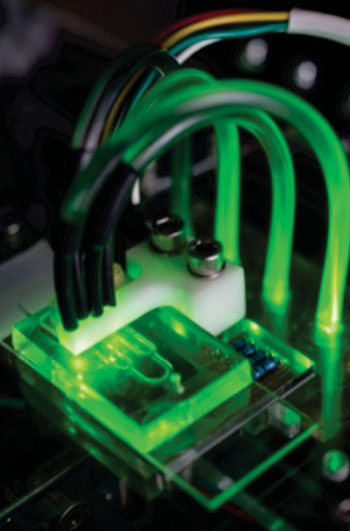Aspirin Found Less Effective Preventing Blood Clots in Atherosclerotic Blood Vessels
By LabMedica International staff writers
Posted on 03 Apr 2014
A novel microfluidic device that mimicked arterial blood flow was used to evaluate the effectiveness of anti-thrombotic drugs under various blood-flow conditions.Posted on 03 Apr 2014
Investigators at the Georgia Institute of Technology (Atlanta, USA) had previously described the design and application of a microfluidic system for simultaneous optical measurement of thrombosis at multiple, well-defined shear rates simultaneously in whole pig blood without the addition of antiplatelet therapies, and presented a proof of concept for applying clinically derived pathological flow conditions to whole blood samples in a microscope-free, high throughput, microscale system.

Image: Artificial blood vessels on a microfluidic chip; the researchers used a device that simulated blood flowing through narrowed coronary arteries to assess effects of anticlotting drugs (Photo courtesy of the Georgia Institute of Technology).
In the current study they applied the microfluidic device to human blood across a range of shear rates and antiplatelet therapy concentrations to accurately, robustly, and statistically quantify metrics of platelet activity for a cohort of 14 human patients.
The investigators examined the effectiveness of two blood-thinning treatments: aspirin and GPIIb/IIIa-inhibitors. GPIIb/IIIa-inhibitors are generally given to patients with a higher heart attack risk. The investigators used the microfluidic device to measure occlusion times and thrombus detachment for a range of initial shear rates and therapy concentrations with eptifibatide (the GPIIb/IIIa-inhibitor), or acetyl-salicylic acid (aspirin). They also measured complete blood counts (CBC) and platelet activity using whole blood impedance aggregometry.
Results published in the January 3, 2014, online edition of the journal PLOS ONE revealed that aspirin had little effect on high shear occlusion times, even at very high doses (up to 20 times the recommended dose). Under aspirin therapy, the thrombi formed at high shear rates were four times more prone to detachment compared to those formed under control conditions. Eptifibatide reduced occlusion when controlling for shear rate, and its efficacy increased with dose concentration. In contrast, the hazard of occlusion from aspirin was several orders of magnitude higher than that of eptifibatide. The results showed similar dose efficacies to low shear measurements using whole blood aggregometry.
The investigators concluded that at lower shear rates, such as found in normal arteries, aspirin was fairly effective at stopping platelets from clumping, but at higher shear rates aspirin was not as effective at preventing these clots. The GPIIb/IIIa-inhibitor was effective at preventing blood clots across all shear rates tested, suggesting that these drugs would be effective for people with the higher shear rates caused by atherosclerosis.
“For a patient being prescribed antithrombotic drugs who is at risk for a heart attack, we can draw a small amount of their blood and quickly push a little bit through this device, and based on that information, tell them to take a certain amount of a certain drug. That is where we are going with this project,” said senior author Dr. Craig Forest, assistant professor of bioengineering at the Georgia Institute of Technology. “These microfluidic devices are so cheap and require so little blood that it could become possible for someone to use this in a disposable, rapid way.”
Related Links:
Georgia Institute of Technology














